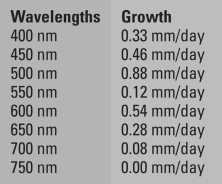Multiple Choice
Please use the following information to answer the following question(s) .
You work for a company selling tropical rain forest plants commonly found in the understory of the forest. These plants are shade tolerant and can be grown indoors because they require low light. Your employer wants you to find out what is the best type of light to maximize growth of these understory plants. Using a full spectrum of natural light would cause these plants to die because they are a shade-tolerant plant species.
From your biology class, you recall that the light-dependent reactions of photosynthesis involve pigment molecules that absorb light of specific wavelengths. You also remember the experiments done by the German biologist Theodor Engelmann, in which he separated light using a prism into different wavelengths and then determined which wavelengths were best for promoting photosynthesis in the algae species he was examining. Your goal is to determine which wavelengths (colors) of light are best for promoting photosynthesis to enhance growth in your species of plant. To achieve this, you grew your plants under different wavelengths of light and measured their growth rates. The wavelengths were measured in nanometers (nm) , and the growth rate was measured in millimeters per day (mm/day) . The data you collected are as follows:

Make a bar graph plotting growth rates on the y-axis and wavelengths of light on the x-axis. Referring to your graph, answer the following question(s) :
-Which wavelength of light is the least useful to your plant's growth?
A) 750 nm
B) 650 nm
C) 550 nm
D) 500 nm
Correct Answer:

Verified
Correct Answer:
Verified
Q9: Please refer to the following art to
Q9: If you provided your shade-tolerant plants with
Q10: Please refer to the following art to
Q12: Refer to the accompanying figure.Plant cells that
Q14: When a molecule absorbs a photon,one of
Q16: Please use the following information to answer
Q17: Which of the following is an autotroph?<br>A)human<br>B)mushroom<br>C)pine
Q21: What is responsible for the yellow-orange coloration
Q28: If a plant appears blue to us,what
Q38: Through what structure(s)do plants obtain most of